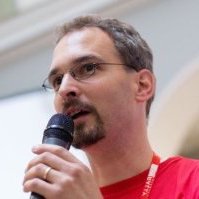5 Questions about Project Management
with Jan Fischbach
Coffee Talk

Before we leave the office for the weekend, we stop for a quick coffee talk with our project management colleagues to chat about their best practices. Well, not literally, but that's how we designed our interview series "5 questions about project management". To be fast, intense and refreshing like a good cup of coffee.
Today, we’ll talk with Jan Fischbach. He is the CEO of CommonSense Consulting, a longtime trainer for Scrum trainer and co-founder of freiräume.camp for new work culture.
1. What is your favorite project management method?
Our customers seek our support mainly for two reasons:
The want to conduct organizational projects (i.e. implementation of ERP software or document management systems) or they want to implement agile methods like scrum which is also an organizational project, of course. In both areas, we mostly use Scrum.
The community views Scrum not as a project management method but as a team process and as a means to deliver good products. And that’s what our work is about: We build teams who start to deliver products and optimize them on a regular basis. Project mangement to us means, deliver results under uncertainties. Project are not approved but financed. Before talking about time and task management, we need a good common understanding in our team what kind of results we should actually deliver. To get to this understanding, we apply
principles of product-based planning of PRINCE2, of Earned Value Management (ANSI 748), Benefits Management (Ward/Daniel), Performance Based Project Management (Alleman), User Story Mapping (Patton) or Impact Mapping (Adzic).
Managers and teams often underestimate the amount of uncertainty they are dealing with. Therefore, we use the framework model of shenhar/Dvir to explain uncertainty in projects. With important proejcts, we recommend a Monte Carlo simulation to test the probability of deadlines and cost. If you work with a three-point estimation and look at 1000 scenarios with random numbers, you often come to realize that your first planning was quite unlikely.
By the way, Ken Schwaber and Jeff Sutherland have published a new version of Scrum guides in November 2017.
2. Do you use project management software for bigger projects? If so, which one?
We are no huge fans of software. Not because of the software quality but because of how software is used. Our goal is stable teams working together in one place. For this, it is often enough to have a free wall, some sticky notes and flip charts. If team members work from different locations, digital support might be helpful. However, we also prefer to use physical boards in those cases and then take pictures and upload these in a shared digital application.
Our customers often use Jira or Trello. However, the amount of data in these tools usually grows faster than people can handle. Everybody is eager to enter data but the administration gets more and more complex because there are more and more mandatory fields. And then, you reach a point where no one has an overview anymore of what was delivered and what still needs to be done. Loading the data and looking for it, takes more time than the actual work itself. Some team members might even go around the software to at least get some work done. In these cases, it is good to stop the usage of the application and pause: What did we want to achieve with this software in the first place? Of course, you can manage open points with lots of software and track work by the hour. But is this really what the software is supposed to do?
3. What is your favorite routine in a project?
I love to use Story Mapping. The employees we meet at our customers are always capable and professional. What is often missing is a common view on things and Story Mapping is very helpful with this. We take one or two hours to better understand the process and the product structure and to deduce work priorities. We also use the maps in the refinement and planning stages.
4. What is the most underestimated factor for project success?
a) Thinking in results: If I look at different studies about project mangement (i.e. PWC: Insights and Trends: Current Portfolio, Programme, and Project Management Practices, The third global survey on management), I come to the conclusion that projects often do not fail because of a lack of knowledge.
I believe, our understanding of project business often gets in our way. Project management is more than putting task lists together and managing cost schedules. Project management means delivering results under uncertainty. The most important question always is: What do we want to deliver or change? The goal of ERP projects is not offering a technical system. Users need specific features. They want to print delivery notes or invoices. DMS projects are not about storage of documents. It’s abut completing team processes. And therefore, we need documents. Which skills do we want to have mastered or learned after the project?
b) Projects are financed and not approved: Projects are too often considered a cost factor. The agile community has changed its perspective. In an agile, projects are not implemented but products which you make or save money with are pre-financed. From an agile standpoint and by the way also in PRINCE2 profitability (business value, business case) is key.
After our clients have estimated the project costs, I often ask how the workflow would need to change to let the company double or triple the income generated. That question starts interesting discussions. In a truly agile context, a product owner is not a project manager but an entrepreneur.
5. What is your biggest time waster?
Unfocussed meetings: I appreciate Scrum because it gets us from ceremonies to results. Every Scrum activity has a clear purpose, either we plan something or we look at results. It’s not about all the effort, it’s only about results. This releases energy. In bad projects there are meetings in which teams go through lists that are far too long. Grown-ups are treated like children who have to explain to their teacher why they didn’t do their homework. It’s aweful. Instead of getting to the toot causes of unrealistic planning, people are put under pressure. This system does not work.
Work overload: All our customers have too long lists of current activities. They take on too much at the same time. Changing between tasks takes lots of time. If an employee is involved in five projects at the same time, he need 75 percent of his time to switch between projects: He attends meetings, writes and reads protocols, hand-overs to colleagues. That is all work which creates no value but demands lots of energy.
Thanks for your time and all the best for your next project.

